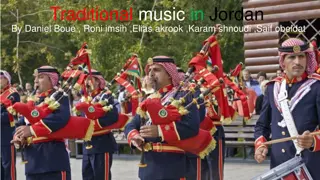Diverse Music Traditions of India - Classical to Folk
Explore the rich musical heritage of India, encompassing classical Carnatic and Hindustani music, folk melodies, film songs, and pop music. Learn about the intricate nuances of Indian classical music, its historical evolution, and the variety of genres within the music landscape of the country.
Download Presentation

Please find below an Image/Link to download the presentation.
The content on the website is provided AS IS for your information and personal use only. It may not be sold, licensed, or shared on other websites without obtaining consent from the author.If you encounter any issues during the download, it is possible that the publisher has removed the file from their server.
You are allowed to download the files provided on this website for personal or commercial use, subject to the condition that they are used lawfully. All files are the property of their respective owners.
The content on the website is provided AS IS for your information and personal use only. It may not be sold, licensed, or shared on other websites without obtaining consent from the author.
E N D
Presentation Transcript
Music of India By Deepak Jamdhade Raut Sachin
The music of India includes multiple varieties of Indian classical music, folk music, filmi and Indian pop. India's classical music tradition, including Hindustani music and Carnatic, has a history spanning millennia and developed over several eras. Music in India began as an integral part of socio- religious
Classical musicMain article The two main traditions of Indian classical music are Carnatic music, which is found predominantly in the peninsular regions, and Hindustani music, which is found in the northern, eastern and central regions. The basic concepts of this music includes shruti (microtones), swaras (notes), alankar (ornamentations), raga (melodies improvised from basic grammars), and tala (rhythmic patterns used in percussion). Its tonal system divides the octave into 22 segments called shrutis, not all equal but each roughly equal to a quarter of a whole tone of the Western music
Hindustani music The Hindustani music tradition diverged from Carnatic music around the 13th-14th centuries CE The practice Vedic times where the hymns in Sama Veda, an ancient religious text, were sung as Samagana and not chanted. Developing a strong and diverse tradition over several centuries, it has contemporary traditions established primarily in India but also in Pakistan and Bangladesh. In contrast to Carnatic music, the other main Indian classical music tradition originating from the South, Hindustani music was not only influenced by ancient Hindu musical traditions, historical Vedic philosophy and native Indian sounds but also enriched by the Persian performance practices of the Mughals. Classical genres are dhrupad, dhamar, khyal, tarana and sadra, and there are also several semi-classical forms.
Carnatic music The present of Carnatic music can be traced to the 14th - 15th centuries AD and thereafter. It originated in South India during the rule of Vijayanagar Empire. Like Hindustani music, it is melodic, with improvised variations, but tends to have more fixed compositions. It consists of a composition with improvised embellishments added to the piece in the forms of Raga Alapana, Kalpanaswaram, Neraval and, in the case of more advanced students, Raga, Tala, Pallavi. The main emphasis is on the vocals as most compositions are written to be sung, and even when played on instruments, they are meant to be performed in a singing style (known as g yaki). There are about 7.2 million ragas (or scales) in Carnatic Music
Light classical music here are many types of music which comes under the category of light classical or semi-classical. Some of the forms are Thumri, Dadra, Ghazal, Chaiti, Kajri, Ta ppa, Natya Sangeet and Qawwali.
Rabindra Sangeet (Music of Bengal) Rabindra Sangeet (Bengali: Robindro shonggit, Bengali pronunciation: [ obind o o it ]), also known as Tagore songs, are songs written and composed by Rabindranath Tagore. They have distinctive characteristics in the music of Bengal, popular in India and Bangladesh."Sangeet" means music, "Rabindra Sangeet" means music (or more aptly Songs) of Rabindra.
Lavani Lavani comes from the word Lavanya which means love. This is one of the most popular forms of dance and music that is practiced all over Maharashtra. It has in fact become a necessary part of the Maharashtrian folk dance performances. Traditionally, the songs are sung by female artistes, but male artistes may occasionally sing Lavanis. The dance format associated with Lavani is known as Tamasha. Lavani is a combination of traditional song and dance, which particularly performed to the enchanting beats of 'Dholaki', a drum-like instrument. Dance performed by attractive women wearing nine-yard saris. They are sung in a quick tempo. The verve, the enthusiasm, the rhythm and above all the very beat of India finds an expressive declaration amidst the folk music of India, which has somewhat, redefined the term "bliss". Lavani originated in the arid region of Maharashtra and Madhya Pradesh.























